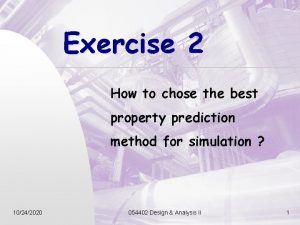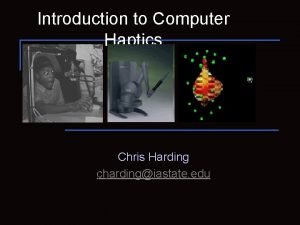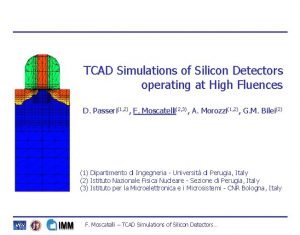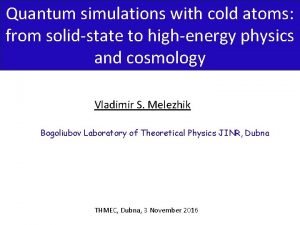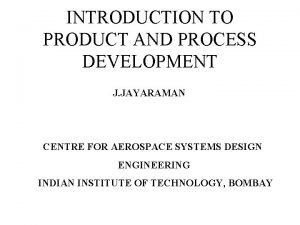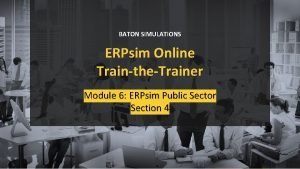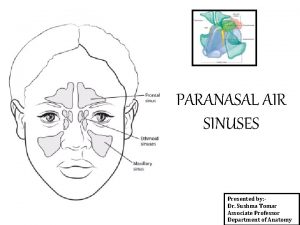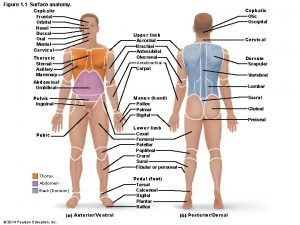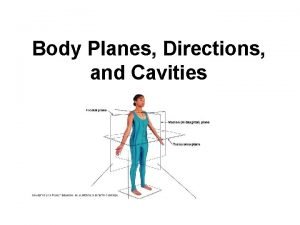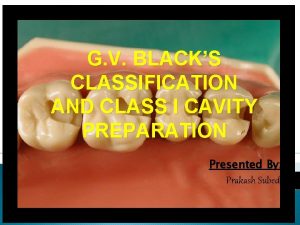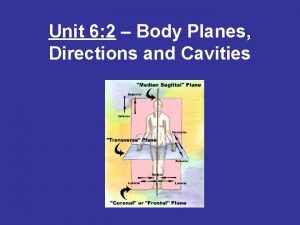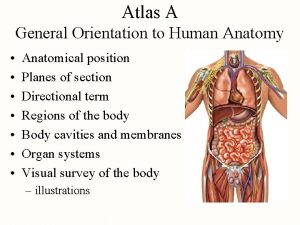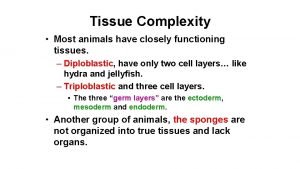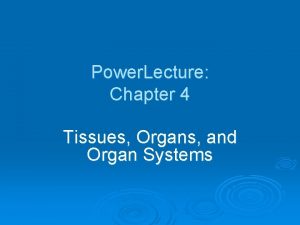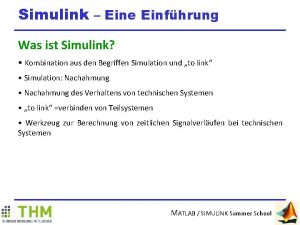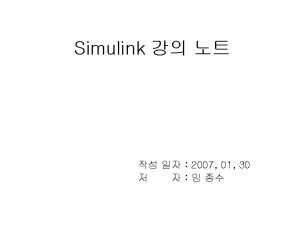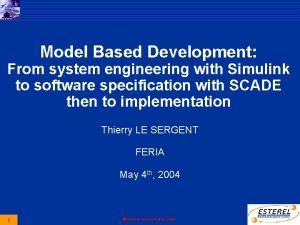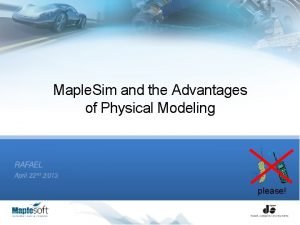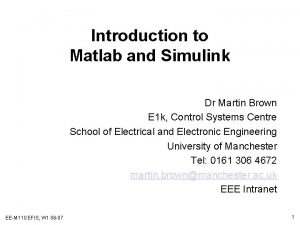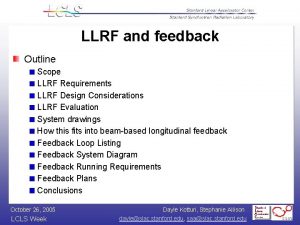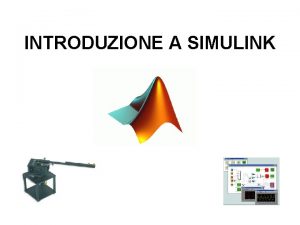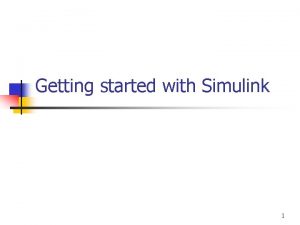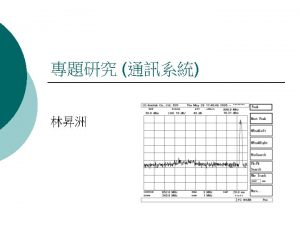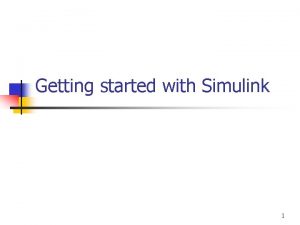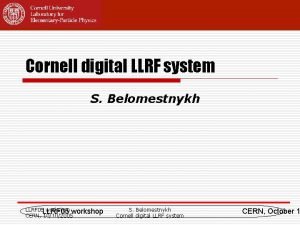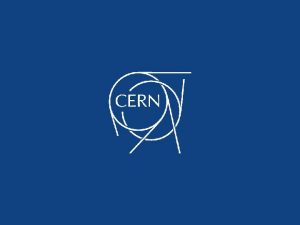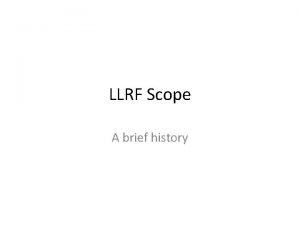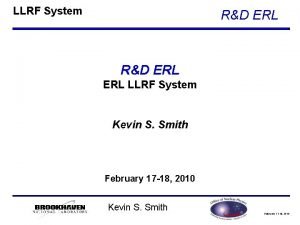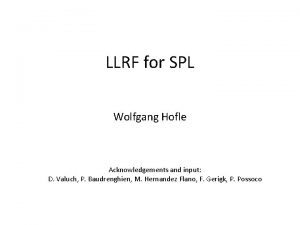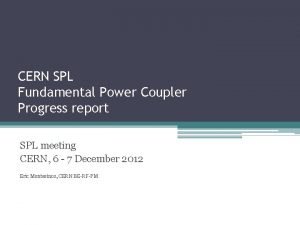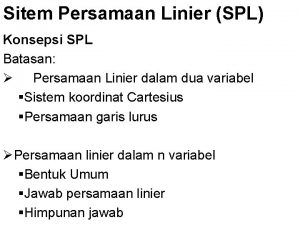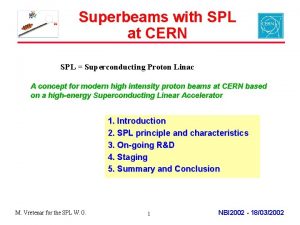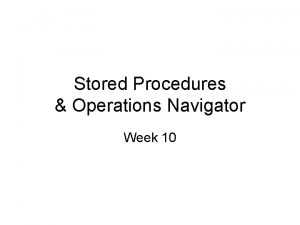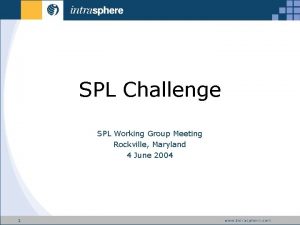LLRF Control Simulations for SPL Cavities Simulink Model








































- Slides: 40

LLRF Control Simulations for SPL Cavities Simulink Model for SPL Extension to LINAC 4 at CERN from RF Point of View Matias Hernandez Acknowledgements: CEA team, in particular O. Piquet (simulink model) W. Hofle, J. Tuckmantel, D. Valuch, G. Kotzian, P. A. Posocco 1

Presentation Overview • SPL Characteristics • Single Cavity/Klystron Model and Simulation Results • Double Cavity/Klystron Model and Simulation Results • Full Accelerator Analysis 2

Current SPL Accelerator Design Parameters • SPL is meant to accelerate H- ions from 160 Me. V up to 5 Ge. V. • 2 sections: 54 β=0. 65 cavities, 200 β=1 cavities. 160 Me. V to 5 Ge. V β=0. 51 to β = 0. 99 • Vacc from 3 MV up to 26. 6 MV, max E field of 19. 3 MV/m and 25 MV/m for each cavity type. • Synchronous angle range from 17 to 13 to minimize longitudinal emittance. • Resonant frequency of RF system was set at 704. 4 MHz to minimize SPL length and allow easy interface with re-commissioned 352. 2 MHz LEP equipment used in LINAC 4. 5 -cell elliptical SC cavities tested at CEA Saclay and INFN

SPL Accelerator Design Parameters (3) • Hydrogen ion source is designed for flexibility and high-power for different end-user requirements in terms of average pulse current and time structure of the beam. • For 5 Ge. V injection acceptance tolerance (PS 2, neutrinos), the control of the cavities’ accelerating voltages during beam pulse is tightly constrained. max +- 0. 5% |V| nominal max +- 0. 5 V phase 0. 4 ms pulses of 40 m. A (high current) beam at 50 Hz repetition rate 0. 8 ms pulses of 20 m. A (low current) beam at 50 Hz repetition rate

Cavity Voltage Control • Possible operation using 1 or 2 cavities controlled via a single feedback loop 1 cavity per klystron • Feedback loop acts on cavity voltage pickup vector average for dual case 2 cavities per klystron

High-Level Diagram of Single Cavity + Control System 6

RF Drive and Generator Model A-A A-P • The specifications for the Klystron and modulator ordered for CERN test stand were taken into account. • Curves were fitted for amplitude-amplitude and amplitudephase transfer characteristics, modulator effects also included. 7

RF Drive and Generator Model Diagram 1 MHz BW

Cavity Model Simplified Diagram Cavity differential equations, generator plus beam loading DC voltage drop result in output curve for cavity voltage. 9

Beam Loading • Infinitely narrow bunches induce instant voltage drops in cavity • Voltage drop is equal to generator induced voltage between bunches creating flattop operation • Envelope of RF signal in I/Q 10

RF Feedback • PID controller • Limit bandwidth in feedback loop to 100 k. Hz • (Klystron bandwidth is 1 MHz) 11

Feed-Forward • System impulse response is pre -calculated and its inverse is stored in the feed-forward controller in matrix form. IMPULSE RESPONSE • The output error is calculated during the beam pulse in normal operation and the feedforward signal is fed to the system during the next beam pulse.

Graphical User Interface 13

Results • Cavity Voltage Amplitude and Phase • Forward and Reflected Power • Additional Power for Feedback Transients and Control • Klystron Modulator Ripple Effects and Feed-Forward Compensation • Effects of Beam Relativistic Beta Factor on Cavity Voltage During Beamloading 14

Cavity Voltage Magnitude and Phase with Lorentz Detuning (Open Loop) Lorentz detuning coefficient K=-1 Hz/(MV/m)2 Linear phase shift for undriven cavity 15

Cavity Voltage Magnitude and Phase (Open Loop Close-Up) Negative Lorentz detuning factor has opposite effect on cavity voltage magnitude with respect to synchronous angle effects. Injection time Negative Lorentz detuning factor has opposite effect on phase with respect to synchronous angle effects. 16

Cavity Voltage Magnitude and Phase (Closed Loop) Injection time 17

Forward and Reflected Power with Lorentz Force detuning Oscillations due to transients during FB loop ON and beam loading. Feedback loop is closed 10 us after generator pulse and open 10 us after end of beam loading. Less power is necessary to maintain cavity voltage due to opposing effects of synchronous angle and Lorentz detuning Injection time 18

High Voltage Modulator Ripple Injection time Variations in the high voltage supply from the modulator to the Klystron cathode have noticeable effects on the output magnitude and phase of the Klystron. A worst case scenario of 0. 2 d. B/% in magnitude and 15°/k. V in phase are specified.

Feed-Forward Effects Feed-forward recursively corrects the residual error in the cavity voltage from pulse to pulse. After a few pulses, the correction minimizes the modulator ripple effects and the initial transients at beam injection on the cavity voltage waveform. Injection time Even with feedback ON, the cavity voltage phase is not ideal during beam loading, thus an extra correction must be applied. Injection time

Transit Time Factor Variation with Relativistic Beta (SPL beta=1 cavities) • The shunt impedance relates the voltage in the cavity gap to the power dissipated in the cavity walls. uncorrected for beam speed • The “effective” shunt impedance relates the accelerating voltage in the cavity to the power dissipated. This quantity describes the voltage that a particle travelling at a certain speed will “see” when traversing the cavity. • The “correction” applied is known as the “Transit Time Factor”.

Transit Time Factor Variation with Relativistic Beta (SPL beta=1 cavities) • Until now, the cavity dynamics have been modeled from the point of view of a beam travelling at the speed of light (β=1), the voltage seen by a β=x beam is simply a scaled version of the cavity waveforms we have already seen. • If beam loading occurs with a slower beam than that of design (in terms of generator power and loaded quality factor), however, the cavity voltage will tend towards a new equilibrium during the beam pulse. • This new equilibrium is a result of the beam absorbing dramatically lower amounts of power as it travels through the cavity. β =1 β =0. 85 22

Transit Time Factor Variation with Relativistic Beta (SPL beta=1 cavities, open loop simulation) Beamloading Values obtained from SUPERFISH simulations by Marcel Schuh (CERN) Beamloading • Weaker beam loading results in a higher flattop equilibrium and less phase shift of the cavity voltage. • Beta value taken from beam energy at beginning of SPL high beta section (farthest from beta=1).

Transit Time Correction • The solution is to lower the forward power to the cavity during beam loading to maintain the voltage flattop. • To do this we find the power required for the equilibrium voltage of the new beam (β=x) to match that of the relativistic beam (β=1). • If where is a known constant, then for a fixed loaded quality factor we need to find the (virtual) generator current such that , therefore

Transit Time Correction (2) Forward power drop at injection time results in flat -top operation Loaded quality factor mismatch during beam loading

High Level Diagram for Dual Cavity + Control System 26

High Level Diagram for Piezo Controller • Similarly to the feed-forward controller design, the piezo algorithm optimizes the mechanical correction pulse by pulse. • The algorithm uses information from the forward and cavity waveforms, as well as the previously known characteristics of the beam

Results • Cavity Phase Variation Without Compensation • Effects of Adaptive Piezo Compensation • Effects of Loaded Quality Factor Variation 28

Vcav Magnitude and Phase for Dual Cavity Case (K=-1 and -0. 5 Hz/(MV/m)2) While the voltage magnitude and phase of the vector average stays within specifications, it is possible that each cavity controlled by the single feedback loop deviates in opposite directions. Due to these effects, it is necessary to manipulate each cavity separately with the piezo controllers to ensure acceptable beam loading 29

Voltage Magnitude and Phase for Dual Cavity Case (Without Piezo-Compensation) K=-0. 5 K=-1 30

Vcav Magnitude and Phase for Dual Cavity Case (With Piezo Compensation) • The piezo system can correct the issues due to mismatches in the Lorentz detuning factor of individual cavities. • Here the cavity voltage phase of both cavities controlled by a single feedback/feed-forward loop are shown. Cavity 1 (K=-1 Hz/(MV/m)2) Cavity 2 (K=-0. 5 Hz/(MV/m)2) • The Klystron is modeled taking into account the effects of the modulator ripple. 31

Loaded Quality Factor Fluctuation Effects on Cavity Voltage Magnitude Variation of 2. 2% in loaded quality factors of each cavity from the nominal can be enough to push the cavity voltage magnitudes beyond the 0. 5% limit. This is, however, a coupled effect. It is interesting, therefore, to investigate the effect of adjacent deviations from the nominal accelerating voltage on the quality of the beam after passing though the whole SPL.

Loaded Quality Factor Fluctuation Effects on Cavity Voltage Magnitude (2) Simulations and figures by Piero Antonio Posocco at CERN The curves labeled 2% to 5% corr. are simulated with an equal correction applied to each cavity after theoretical extraction points to ISOLDE (1. 4 Ge. V) and EURISOL (2. 5 Ge. V). The phase of each cavity after these points is shifted by the measured cumulative phase change of the beam pulse. This results in double the flexibility in terms of loaded quality factor. Full simulations show that for an output jitter of 0. 1% of the SPL beam kinetic energy (≈5 Me. V), if we take a 99% bound for beam within specifications, we can see that the maximum deviation from the nominal accelerating voltage for coupled cavities is of around 1%. This translates to about 4 % difference in loaded quality factor for two cavities controlled via a single feedback loop acting on their vector average. The quality factor difference between 2 cavities controlled by a single feedback loop can be very restrictive.

Full SPL Effects Analysis • Investigated small errors in cavity magnitude and phase and their cumulative effects on beam quality. • The worst case scenario of repetitive errors on all 254 SPL cavities extrapolated from single cavity simulations was scrutinized. 34

Cumulative Error Along Full SPL due to Feedback Loop Transient (1) 254 cavities Injection Time (start of beam pulse) Power Gain Along SPL 1200 1000 power 800 (k. W) Beta = 0. 65 High Power SPL Beta = 0. 65 Low Power SPL 600 Beta = 1 High Power SPL Beta = 1 Low Power SPL 400 232 211 cavity number 190 169 148 127 106 85 64 43 22 1 0

Cumulative Error Along Full SPL due to Feedback Loop Transient (2) • The SPL is comprised of 254 cavities with RF phases that are designed to fit the acceleration of the hydrogen ion beam as it traverses its length. • The cumulative effect of a 0. 3 degree phase deviation on each cavity at beam arrival can result in merging of beam bunches and a deterioration in the output energy of particles. • The difference in “time of flight” (To. F) for a single charge that receives full acceleration as opposed to that which experiences a 0. 3 degree deviation at arrival on each SPL cavity, is two orders of magnitude higher than the bunch separation. • The kinetic energy variation from nominal at SPL output is higher than 0. 1% To. F 0 = 2137. 8 ns To. F 0. 3 = 2438. 4 ns TRF = 1. 4 ns E 0 = 4935 Me. V E 0. 3 = 724 Me. V To. F 0. 3 - To. F 0 >> TRF d. E 0. 3 deg >> 0. 1% Eo

Feed Forward Correction for Cumulative Error along SPL (1) • We measure the vector deviation of the cavity voltage from its ideal and add an excitation to the power source feeding the cavity that nullifies it. • The excitation to the power source (generator current) is dependent on the transient relationship between cavity and generator.

Feed Forward Correction for Cumulative Error along SPL (2) • Easiest solution is to intersperse slow feed-forward so that each SPL cavity will have the opposite error from the preceding one along the accelerator, “randomizing” the error. injection • In this way, particles travelling along the LINAC will not experience an accumulated deviation. Feed forward ON before injection To. F 0. 3 - To. F 0 < TRF d. E < 0. 1% Eo

In Summary… • In order to cater for the needs of project specifications in constant need of revision, a high flexibility simulation model developed, with a GUI for data processing. • Flexible graphical user interface allows for efficient handling of simulation data • 1 and 2 cavities per Klystron schemes can be observed from RF point of view under a wide set of circumstances • Can estimate practical issues that can arise during development of a real LLRF system in terms of power, stability of accelerating field and technology necessary for operation 39

Next Step • Characterize a Klystron polar loop to deal with modulator ripple and non-linearities • Develop DSP/FPGA hardware to implement the control loops simulated • Investigate feed-forward schemes using system identification algorithms in order to update the feed-forward controller during normal SPL operation (using random signals) 40
 Cruise control matlab
Cruise control matlab Don't gamble with physical properties for simulations
Don't gamble with physical properties for simulations Clinical simulations in nursing education
Clinical simulations in nursing education Chris harding simulations
Chris harding simulations Tcad simulations
Tcad simulations World history simulations
World history simulations Simulations for solid state physics
Simulations for solid state physics Payroll card
Payroll card Key tenets of ippd
Key tenets of ippd Baton simulations
Baton simulations Jhuma biswas homeopathy
Jhuma biswas homeopathy Body cabities
Body cabities The anterior and posterior body cavities
The anterior and posterior body cavities Middle meatus drainage
Middle meatus drainage Hypochondriac region
Hypochondriac region Body planes and directions
Body planes and directions Thoracic cavity and abdominal cavity
Thoracic cavity and abdominal cavity Body cavities labeled
Body cavities labeled Palms facing forward
Palms facing forward Cricothyroid membrane
Cricothyroid membrane Gv black's classification
Gv black's classification Echinoderms cephalization
Echinoderms cephalization 7.2 body planes directions and cavities
7.2 body planes directions and cavities Covers body surfaces and lines body cavities
Covers body surfaces and lines body cavities The brain contains four lined cavities called
The brain contains four lined cavities called Anterior/ventral
Anterior/ventral Organs in each quadrant
Organs in each quadrant Medial plane
Medial plane Health science 20
Health science 20 Major body cavities
Major body cavities Major body cavities
Major body cavities Animal body cavities
Animal body cavities Body cavities
Body cavities Body cavities
Body cavities What is sweeteners
What is sweeteners Simulink alternative
Simulink alternative Unit delay in simulink
Unit delay in simulink Scade vs simulink
Scade vs simulink Matlab workspace
Matlab workspace Maplesim vs simulink
Maplesim vs simulink Introduction to matlab and simulink
Introduction to matlab and simulink

